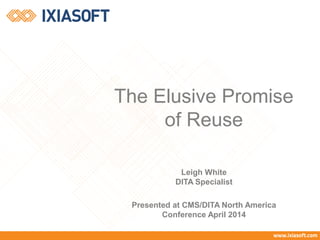
The Elusive Promise of Reuse
- 1. The Elusive Promise of Reuse Leigh White DITA Specialist Presented at CMS/DITA North America Conference April 2014
- 2. Typical obstacles to effective reuse • Content is too “owned” • Content is too siloed • Content is too big or too contextual • Content is too unknown • Reuse is too random • Reuse is too untracked • Time is too paradoxical
- 3. Content is too “owned” • Natural result of traditional authoring environment Each writer is responsible for “his/her” documents/books/files/projects These items live in folders that only the “owner” touches
- 4. Content is too siloed • Content for different products developed by different writers on same team or even different teams • Different voice, different style, different approaches • Each silo believes it has the best approach
- 5. Content is too big or contextual • Content is written in large, hierarchical chunks that cannot be easily manipulated or recombined • Content pieces are written too contextually “In the previous section…” “In the next topic…”
- 6. Content is too unknown • Deliverables might be inventoried but very rarely any content level below that • Even if you’re using a CMS, do you really know what you have? • You have to know what you have before you can develop a reuse strategy. • After analysis, you might find that you don’t have as many opportunities for reuse as you thought.
- 7. Reuse is too random • “Reuse” as you go approach • “Writing yourself into a corner,” creating content that’s difficult or impossible to reuse as-is • Ad hoc planning that only fits an immediate need with no idea how it fits into a bigger picture Developing a strategy takes time Work goes on; new content must be created before the strategy is complete You might have to revisit content after the strategy is developed
- 8. Reuse is too untracked • What’s been reused? Where? • If I change this topic, what else is affected? • A CMS helps (immensely), but it’s not the complete answer A CMS is not a reuse strategy! It is a tool that helps you implement a reuse strategy.
- 9. Time is too paradoxical • We need to reuse to save time. We need to plan our reuse. Planning takes time. We don’t have enough time. We need to reuse to save time.
- 10. Reuse strategy!!! • You will not succeed in effectively reusing content without one • A reuse strategy defines: How granular your reuse will be: topic-level, element- level, phrase-level The metadata you’ll use to create categories that enable you to find applicable reusable content The criteria that determine when pieces of content should combine or diverge
- 11. Reuse strategy con’d Who can edit reusable content and what review/approval process will be Communication/notification methods for helping writers coordinate reuse*** How/where to store and find reusable content***
- 12. Content inventory • Essential first step to effective reuse • Use representative but manageable subset of content A self-contained current project Most-frequently-used content • Create spreadsheet of topics and where they are used • Compare titles to find topics that are likely the same or very similar • Decide when similar topics can be combined or need to remain separate
- 13. Content inventory con’d • Develop criteria for determining when different is "too different" • Determine what conditions you'll need to distinguish content and how/when to apply them • If you have a glossary, search for variations on those terms to find inconsistent usages • Review indices to Look for inconsistencies Develop a keyword list as a first step towards common vocabulary
- 14. Content inventory con’d • Review and classify topics beyond concept, reference, task You probably have several different types of concepts, references, and tasks. Determine the way each of these types should be organized and patterned
- 15. Opportunities for reuse • From within Reuse topics in multiple outputs with conditions Reuse notes, warnings, legal verbiage, support information, steps, sub-maps • From without Tech support information Training material Error messages from the software code Product specifications from R&D Marcom (product descriptions, etc.)
- 16. Don’t go overboard • Individual words and phrases are not good candidates for reuse. • It can be more trouble to insert and track a “Click Save” type conref than simply to type the phrase. • Evaluate the effort against the return
- 17. Apples to apples, dogs to ducks • Sometimes two presentations of the same content are so different that reuse is not practical Consider information that appears in a huge table in a reference guide but also needs to appear in bulleted lists or paragraphs in another output. Setting this content up in a neutral way to apply “the usual” reuse mechanisms to it could be tricky. In such a case, you’re probably looking more at some specialized processing than simple reuse.
- 18. Communication is key • While some CMSs will track and notify of reuse, they are not the complete solution • All writers must understand and follow the strategy • No more silos! • No more ownership!
- 19. Tracking reuse • Very challenging to do manually • A CMS is almost mandatory Track each reusable component and where it is used Some CMSs can notify all authors of topics that reference changed shared content • But you’re still going to have to talk to each other!
- 20. Questions?
- 21. Resources • Managing Enterprise Content: A Unified Content Strategy, Ann Rockley, Charles Cooper • DITA Best Practices, Laura Bellamy, Michelle Carey, Jennifer Schlotfeldt • Content Strategy 101, Sarah O’Keefe, Alan Pringle • “Reduce, Reuse, Recycle: Developing a Reuse Strategy for DITA,” DITA Chicks blog ( http://ditachicks.com) • “Designing Your Information Architecture for Content Reuse: Five Best Practices” (Amber Swope, The Content Wrangler blog, http://thecontentwrangler.com)
